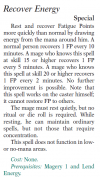- Joined
- May 15, 2017
- Messages
- 7,621
- Reaction score
- 19,697
So, I was going to bitch like an old person about how people make their own damn system instead of just using someone else’s well trodden path, but instead I’ll turn it around and propose a discussion about Actually New Mechanics. How many of these are there actually?
there is a side discussion here about tuning your mechanics to get the setting representation you want, because there are lots of “new mechanics” that are somehow better for someone’s pet setting, snd really, they aren’t new, and they are poorly tested or the math is poorly thought out.
my contention is that there are actually pretty few of these
there is a side discussion here about tuning your mechanics to get the setting representation you want, because there are lots of “new mechanics” that are somehow better for someone’s pet setting, snd really, they aren’t new, and they are poorly tested or the math is poorly thought out.
my contention is that there are actually pretty few of these



 . So the only "new" part in it is Passions. And they're brilliant, though you can argue they were already used in Griffin Mountains
. So the only "new" part in it is Passions. And they're brilliant, though you can argue they were already used in Griffin Mountains .
.


